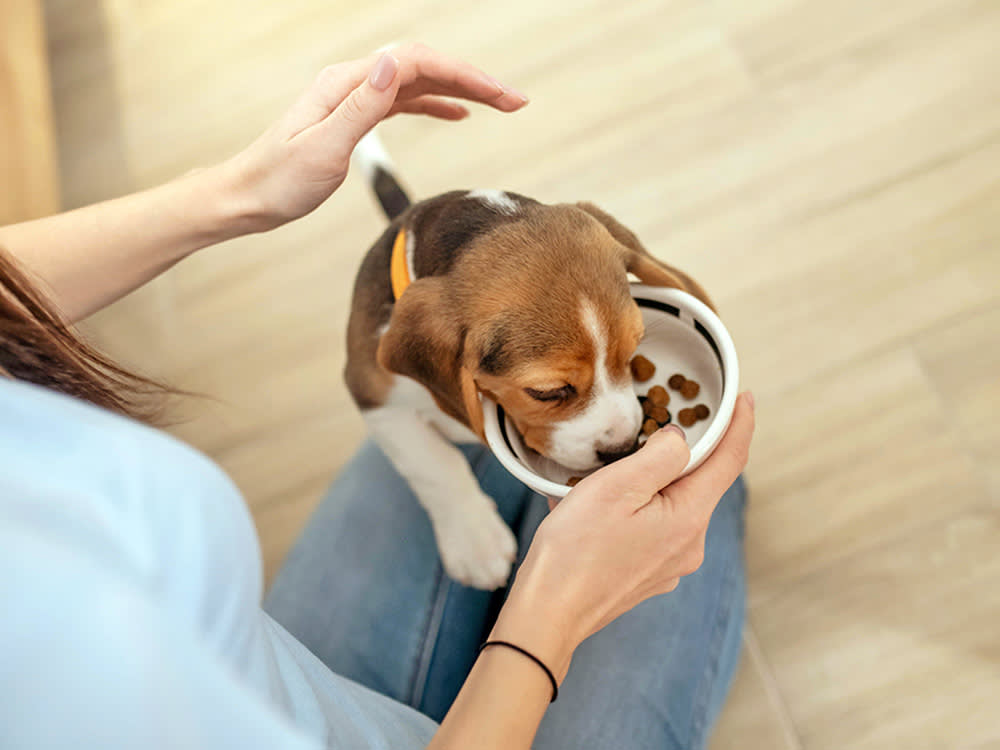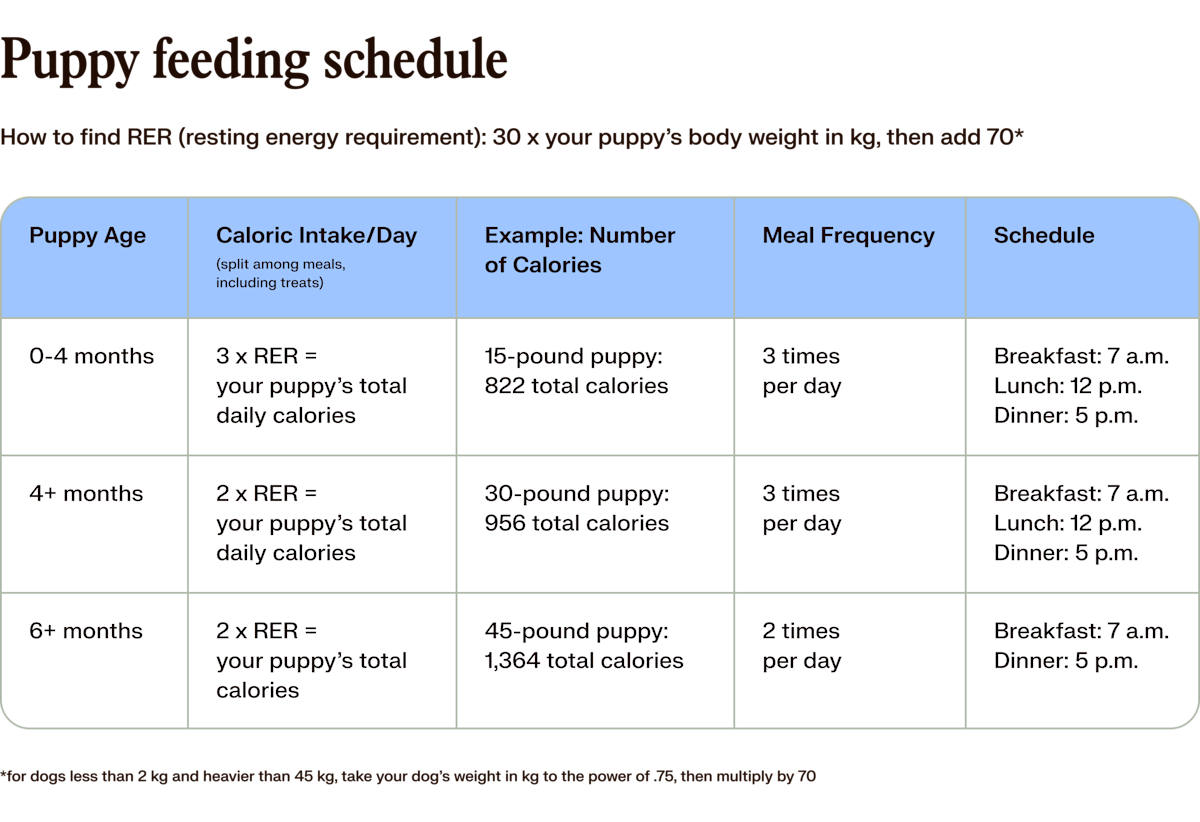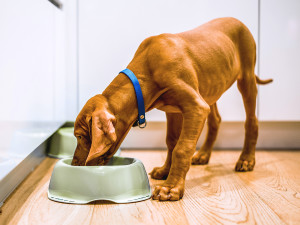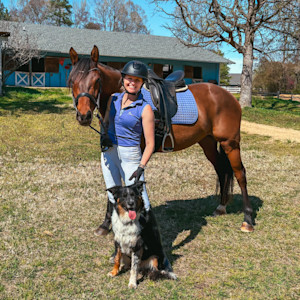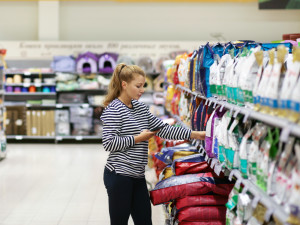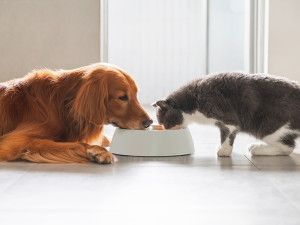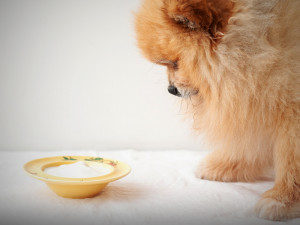Puppy-Feeding Schedule 101
They might act hungry all day, but it’s up to you to know the facts.
In This Article:
Puppy Feeding Chart When Do Puppies Start Eating Food? How Much Should You Feed Your Puppy? How Often Should You Feed Your Pet? Puppy Feeding Schedule By Age How to Find the Best Puppy Food Frequently Asked Questions
Congrats — you just brought home a new puppy! While puppies can bring so much joy and fun to our lives, they also come with a lot of questions. One of the first, and most important, is: What should my puppy eat, and when? There are so many puppy foods on the market that it can be overwhelming to choose. Plus, a fast-growing pup surely needs to eat more than an adult dog, right? But how much more often?
In this puppy-feeding guide, we worked with experts to break down the essentials of puppy-feeding schedules, portion control, and tips for sticking to a routine. From their first nibble of kibble to transitioning into adult dog food, you’ll have everything you need to keep your puppy on track — and avoid those big puppy eyes begging for a little extra.
When do puppies start eating food?
In terms of canned food and kibble, puppies can start eating solid food at around three to four weeks old. “Puppies around this time are weaned from their mother’s milk and can begin their puppy diet,” veterinarian Dr. Helle Brandrup tells us.
How much do you spend on your pet per year?
She also suggests giving them a milk replacer with their food for a couple of weeks to ease their transition and help them adjust. But by the time they hit six weeks old, puppies can have normal puppy food without the extra moisture.
How much should you feed your puppy?
Figuring out how much to feed your puppyopens in new tab highly depends on their breed, weight, and activity level. Small breed puppies might only need half a cup of food while larger breeds would need more.
Veterinarian Dr. Emma Fulton, senior vet contributor to WhiskerWittyopens in new tab, says to look at the feeding guidelines on reputable puppy food bags as a good starting point. “I always suggest checking in with a vet to tweak the portions as the puppy grows. This keeps them on the right track without overfeeding or underfeeding.”
Calculating food portions by weight
A lot of veterinarians suggest using the resting energy requirement (RER) to determine how much food your puppy should be eating. This gives an exact calorie count for your puppy depending on their weight and what stage of life they’re in.
RER: 30 × (your puppy’s body weight in kilograms) + 70
The formula can seem a little complicated when first looking at it, but we promise it’s pretty straightforward. As an example, let’s say we have a six-month-old puppy who is approximately 30 pounds. Divide that weight by 2.205 to convert it to kilograms, equalling 13.6 kilograms. Add that to the formula and you’ll get the number of ��“kcals” or calories.
RER: 30 × (13.6 kg) + 70 = 478 kcal, or calories
“The RER formula is a helpful tool to calculate their baseline energy needs. Once you have the RER, you can adjust the portion size based on the caloric content of their food and their activity level,” Dr. Fulton explains.
Now, multiply that number by the ratio that best describes your puppy’s activity level. The younger your puppy, the higher the ratio — which means the higher the caloric intake for their quickly growing bodies. In our example, we’ll multiply our RER of 478 by two for our six-month-old puppy, equalling 956 calories per day (split between all of their meals and including treats).
Note that for dogs who weigh less than two kilograms or more than 45 kilograms, the findings will be more accurate if you take your dog’s weight in kilograms to the power of .75 x 70, so, for a three-pound (1.36 kg) puppy, it would be:
RER: 70 x (1.36 kg)^.75 = 88 calories a day
How often should you feed your puppy?
Feeding frequency is as equally important part as portion sizes for puppies. Puppies under six months should typically be fed three times a day, which gives them ample energy and supports their fast growth. “After six months, cutting back to two meals a day works well, and by one year, most dogs stick with two meals a day,” Dr. Fulton explains. Depending on their breed and lifestyle, some dogs may do well on just one meal per day.
What are the best times to feed a puppy?
Dogs and puppies should eat on a set schedule versus leaving a bowl out for them to “free feed” whenever they want. Having set feeding times gives your puppy a routine, helps with potty training, and gives your dog’s body the necessary time to properly digest between meals. For puppies eating three meals a day, it’s a good idea to spread them out evenly as breakfast, lunch, and dinner. For example:
Breakfast meal: 7 a.m.
Lunch meal: 12 p.m.
Dinner meal: 5 p.m.
Puppy-feeding schedule by age
While there isn’t a one-size-fits-all puppy-feeding schedule, most puppies should start out at three meals per day, then move down to two as they get older. (More on that below.)
Different breeds, ages, weights, and expected full-grown sizes might need different portions, though. “A puppy with an [expected] weight of eight to 10 pounds might be given half to one cup of food daily,” Dr. Brandrup explains. “But if their [expected] weight is 30 to 50 pounds, they should be fed two and a half to three cups of food.”
The number will of portions and sizes always depend upon their breed and expected adult size. It’s best to go off of the feeding guidelines on your puppy’s food bag, using the RER formula, or working directly with your vet.
Before three months
For young puppies (around eight weeks), Dr. Fulton recommends feeding four to five times a day; their small stomachs require frequent, smaller meals. When weaning off of their mother’s milk, it’s a good idea to add some milk replacer to their meal portions while transitioning to puppy food. And make sure the canned food or kibble is appropriately formulated for puppies. It’s vital they get the right nutrients for their fast-growing bodies.
For three to six month old puppies
By three months, most puppies can move to three meals a day and be strictly eating solid puppy food. This is a good time to set up a regular feeding routine, such as a morning, mid-day, and evening meal schedule.
For puppies six months to 12 months
“Once puppies hit six months, they can switch to two meals per day,” Dr. Fulton says. Pet parents may have to vary the portion sizes depending on if they get their puppy spayed or neutered during this time. If so, their energy levels are likely to go down and they won’t need as many calories as an unfixed puppy.
For puppies after one year of age
Most puppies can continue with a twice-daily cadence for meal times into their adulthood years. After they turn a year old, you can start transitioning them onto an adult maintenance dog food versus the high-nutrient puppy food. However, if you have a large-breed pup, it’s beneficial to keep them on puppy food for a while longer; they can take longer to develop fully.
How to find the best food for puppies
Most importantly, puppy parents need to choose a “puppy-specific” dog food formula to make sure their puppy receives the right nutrients for their growing bodies. The best food for your puppy will also depend on their breed, expected adult size, and activity level.
If you have a large- or giant-breed puppy, they’ll likely need a large-breed specific puppy food to help with developing their slower-growing bodies. Small or medium breeds, on the other hand, likely won’t need the same nutrient levels and would do best with a small-breed puppy food that matches their quicker development timeline.
If you aren’t sure where to start looking, your vet can give you ideas of good puppy foods for your specific pup.
Should you feed your puppy dry food or wet food?
When puppies are first weaning off of their mom’s milk or a milk replacement formula, some vets recommend mixing in some of the milk replacer with wet food to slowly start the transition — especially for puppies who aren’t keen on hard kibble yet. Once they reach six weeks old, puppy parents can move to feed a wet food/kibble mix. This will keep the kibble soft, and it may be more enticing to eat.
It also helps make sure your puppy is getting enough moisture during weaning. Then, you can stop adding the wet food and offer just hard kibble. Some dog parents prefer to feed wet food, while others prefer dry. It really comes down to your dog’s specific needs.
Regardless of whether you feed wet or dry food, make sure it’s a balanced puppy formula. And you can always talk to your vet about the benefits or downfalls of feeding canned versus kibble.
How much does puppy food cost?
Per USA Today, pet parents can expectopens in new tab anywhere from $200 to $700 per year on dog food (Kinship’s own 2024 research found that pet parents’ spending equals an average of $542 per year). The cost of puppy food can vary greatly, though this depends on the brand, whether it’s wet versus dry versus fresh, and if it’s a special formula (such as a large-breed puppy).
FAQs
How many calories should a puppy eat?
A puppy’s calorie needs will depend on their weight, age, and activity level. Using the RER formula will give pet parents a good baseline to work with when figuring out how much to feed their puppy.
“For instance, a 10-pound puppy might require around 600 calories daily, while a 20-pound puppy could need closer to 1,200 calories,” Dr. Fulton explains. “Puppies under four months generally need about three times their RER, while those older than four months typically need twice their RER.”
What are the benefits of feeding a puppy on a schedule?
Consistency is key for puppies, so keeping their meal time the same every day will help regulate their digestion and appetite. Not only does this immensely help with potty training (i.e., knowing your puppy will need to poop and pee after meals), Dr. Brandup explains that it’s more important when your puppy is in the growing stage. “Irregular meals and feeding times can disrupt their nutritional needs, leading to improper development and weaker bones.”
What to do if your puppy isn’t eating during the scheduled time?
If you’re having a hard time getting your puppy to stick to eating on a schedule (or if you have a picky puppy), you can first try to make their food more appetizing. Add warm water, mix in a little bit of wet food, or change the bowl they eat out of. Cut back on treats throughout the day to see if this increases their hunger during meal times. If they still won’t eat after about 10 minutes, pick up the food and try again at their next scheduled meal. When in doubt, reach out to your vet for ideas and to make sure there isn’t something health-related causing the lack of appetite.
Tips for sticking to the schedule while away from home
If you work long hours away from home or have upcoming travel planned that will keep you away from your puppy, it’s important to have a plan in place to stick with their scheduled feeding times. Hiring a pet sitter or dog walker to check on your puppy during the day while you’re out can help them keep a routine. Or, if you’re close enough by, plan your lunch break around the time your puppy should eat their midday meal and head home to spend lunch with them. Pre-portioned meals can also help if you enlist a friend or neighbor to help with feeding times if you can’t get home.
Best location to feed a puppy
Puppies can be messy eaters, especially if they’re eating wet food. Pick a place in your home that will be easy to clean up (like a tile floor) and away from the hustle and bustle of home life so your puppy won’t be distracted during meals. Also, make sure they’re away from other pets that may be eating at the same time to avoid sharing meals. Or, if you’re crate training your pup, feeding them in their crate can help with getting them used to being in there.
When can puppies start eating adult dog food?
The timing for switching to adult food varies depending on the size of the breed. Dr. Fulton tells us that small breeds can usually transition around nine to 12 months, medium breeds around 12 to 14 months, and large breeds may take up to 24 months to fully mature. “It’s essential to transition gradually over a week or so to avoid any digestive issues,” she says.
Why do puppies need special food?
Puppies have different nutritional requirements than adult dogs. They need higher levels of protein, fat, calcium, and phosphorus to support their growing bones and overall development, and puppy food is specially formulated to meet these needs. “Adult dog food doesn’t provide the right nutrient balance for puppies, which is why sticking with puppy-specific formulas is important until they reach maturity,” Dr. Fulton says.
Is it OK to feed puppies table scraps?
Dr. Fulton explains that feeding table scraps to your puppy can be a bit tricky. “Some research suggests that introducing unprocessed, meat-based scraps might be beneficial for digestive health,” she says, but it’s crucial to ensure the food is safe — some human foods, like onions or garlic, are toxic to dogs — and won’t cause any nutritional imbalances. It’s best to stick with a balanced puppy diet for proper nutrition.
Is free-feeding a puppy better?
Free-feeding isn�’t recommended for puppies. Leaving food out all day can lead to overeating (which can cause bloating and digestive issues) and obesity. Scheduled feedings also make it easier to monitor how much your puppy is eating and how their appetite is changing, which can help identify potential health issues early.
How should you incorporate puppy treats into a feeding schedule?
Treats should only ever make up 10 percent of your dog’s diet, puppies included. This can be a little more sensitive with puppies, however, because of their specific nutritional needs compared to an adult dog. It’s best to feed treats sparingly, especially around mealtimes. If you’re trying to get your puppy on a set feeding schedule, you don’t want to accidentally make them full on a bunch of treats before giving them a full meal.
References:
Report: Kinship’s Segmentation, April 2024
